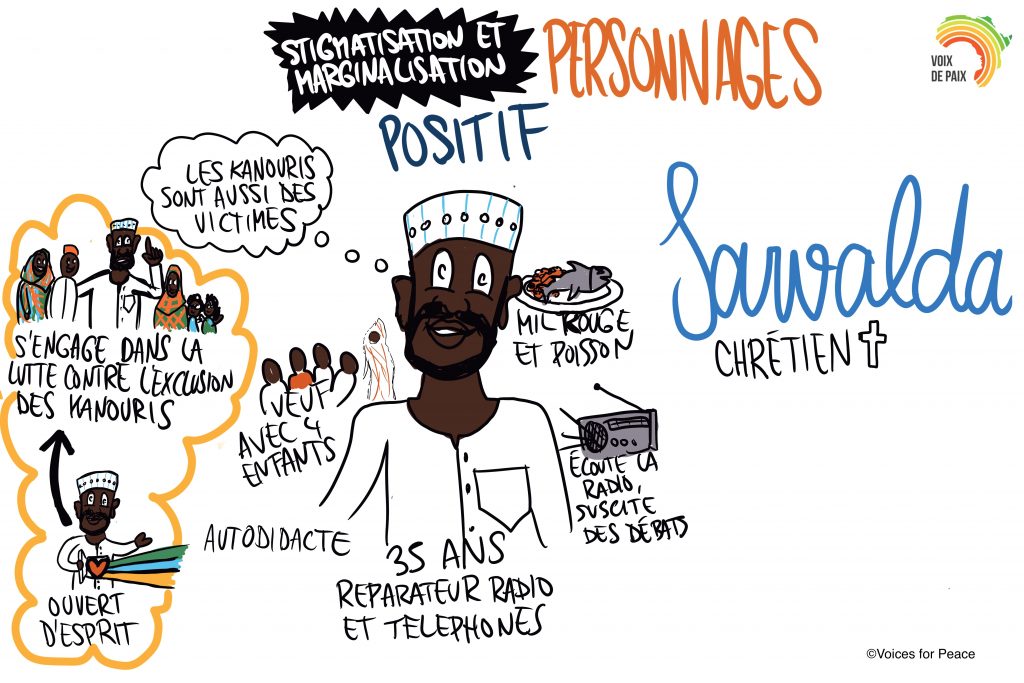How to create an educational radio soap with a pencil
Can images help to counteract stigmatization and discrimination? A radio project in West Africa uses the “soap opera approach” to bring about change in everyday consciousness. Bikablo is penciling in the story concept.
SHARE ARTICLE
In this project we meet our colleague Mirko Hoff again. His goal: to use storytelling to raise awareness of the discrimination faced by the Kanouri people in northern Cameroon in everyday life. These are often associated with the extremist sect Boko-Haram as a result of a fallacy and thus stigmatized.
How does one make oneself heard when unreflective behavior patterns have become established in everyday life? In this case, through a radio soap opera that makes social and political discourse more comprehensible and exciting. Together with Equal Access, an organization that helps countries in Africa, Asia, and the Middle East address critical challenges through the use of media, Mirko works to prevent radicalization of citizens and create an inter-community dialogue that counteracts stigmatization. Listeners accompany fictional characters in their daily lives in their villages and, in the best case, develop together with them, as is known, for example, from the “catharsis” in ancient tragedies.

What can we as visual practitioners contribute to the development of an audio format? In this case, above all, a visible and concrete starting point for virtual collaboration. During the creation of the script for the radio show, Corona intervened and the participants could only communicate with each other via video chat. As is often the case, without direct contact there is no central opportunity to check common understanding. In order to keep this not entirely barrier-free work focused, to think together and to be able to record all results, Filippo Buzzini accompanied the planning for bikablo as Scribe. On the one hand, everyone involved can see on an ongoing basis what work has been done and what results have been achieved. On the other hand, by looking together at the resulting images, one uncovers a possibly divergent understanding or topics in need of discussion that would otherwise have been overlooked. In any case, the feedback from the participants was more than enthusiastic.
During our evaluation meeting, project manager Katiella Gaptia (Equal Access International, Voices for Peace) summed it up like this: “I didn’t expect the visualization to bring such a boost to the joint work. For some collaborators, Filippo’s image made their own vision of our action site and the individuals possible in the first place, because it set the inner stories in motion. I wonder why we don’t work much more with Visual Facilitating in countries where storytelling has such a tradition and still has such an impact today. We will definitely stay tuned here and continue to expand the visual work!”
How exactly visualization was used here and what Filippo Buzzini’s experience was, you will learn in our next blog post. We will also report on how we want to support the training of visual facilitators on site with the help of the bikablo Global Trainer Program.
MORE ARTICLES ON THIS TOPIC
You Might Also Be Interested In...

Using pictures to promote a good climate: bikablo meets Fridays For Future
With “Fridays for Future” a fascinating worldwide youth movement has emerged. bikablo supported the summer congress in Dortmund with graphic recording and visualization trainings.

Closer than we thought: Visualization and Comics
What do graphic novels and graphic recording have in common? This is the question bikablo asked itself in a conversation with the comic artist Oliver Scheibler at the Comic Festival in Cologne. An experience report with surprising insights.

A Look Inside bikablo E-xtraClass
How do I keep up after the basics training? With the bikablo e-xtraClass, the online format for practicing, exchanging and deepening! Trainer Michaela Ruhfus reveals what all basics graduates can now look forward to.